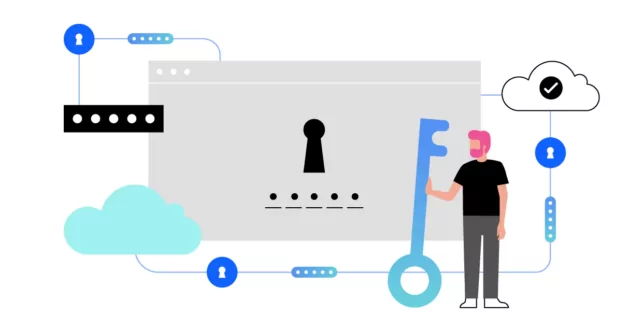
Artificial intelligence is used in healthcare for everything from answering patient questions to assisting with surgeries and developing new pharmaceuticals, benefitting both patients and healthcare systems.
How does artificial intelligence benefit healthcare?
According to Statista, the artificial intelligence (AI) healthcare market, valued at $11 billion in 2021, is projected to be worth $187 billion in 2030. That massive increase means we will likely see considerable changes in how medical providers, hospitals, pharmaceutical and biotechnology companies, and others in the healthcare industry operate.
Better machine learning (ML) algorithms, more access to data, cheaper hardware and the availability of 5G have contributed to the increasing application of AI in the healthcare industry, accelerating the pace of change. AI and ML technologies can sift through enormous volumes of health data—from health records and clinical studies to genetic information—and analyze it much faster than humans.
AI can help make healthcare operations more efficient
Healthcare organizations are using AI to improve the efficiency of all kinds of processes, from back-office tasks to patient care:
- Administrative workflow: Healthcare workers spend a lot of time doing paperwork and other administrative tasks. AI and automation can perform many of those mundane tasks, freeing up employee time for other activities. For example, doctors and other clinicians can dictate notes hands-free, giving them more face-to-face time with patients. AI computer-assisted documentation can provide clinicians with suggestions that keep medical records as thorough as possible. AI can also help with accurate coding, information sharing between departments and billing.
- Virtual nursing assistants: One study found that 64% of patients are comfortable with the use of AI for around-the-clock access to answers that support nurses provide. AI virtual nurse assistants—which are AI-powered chatbots, apps or other interfaces—can answer questions about medications, forward reports to doctors or surgeons and help patients schedule a visit with a physician. This sort of routine monitoring and scheduling takes tasks off the hands of clinical staff, who can then spend more time directly on patient care, where human judgment and interaction matter most.
- Dosage error reduction: AI can help identify errors in how a patient self-administers medications, leading to better patient health outcomes and reduced healthcare costs and hospitalizations. One example comes from a study in Nature Medicine, which found that up to 70% of patients don’t take insulin as prescribed. Using an AI system of wireless sensing, a tool that sits in the patient’s background (much like a Wi-Fi router) can flag errors in how the patient administers an insulin pen or inhaler.
- Safer surgeries: In some instances, AI allows surgeons to operate in tiny spaces instead of doing open surgery. AI-enabled robots can work around sensitive organs and tissues, reducing blood loss, infection risk and post-surgery pain. Robotic surgery often means less scarring and shorter recovery times than traditional surgery.
- Fraud prevention: Fraud in the healthcare industry is enormous, at $380 billion/year, and raises the cost of consumers’ medical premiums and out-of-pocket expenses. Implementing AI can help recognize unusual or suspicious patterns in insurance claims, such as billing for costly services or procedures not performed, unbundling (which is billing for the individual steps of a procedure as though they were separate procedures), and performing unnecessary tests to take advantage of insurance payments.
AI can improve the healthcare user experience
A recent study found that 83% of patients report poor communication as the worst part of their experience, demonstrating a strong need for clearer communication between patients and providers. AI technologies like natural language processing (NLP), predictive analytics and speech recognition can lead to healthcare providers having more effective communication with patients, which can lead to better patient experience, care and outcomes. AI can, for instance, deliver more specific information about a patient’s treatment options, allowing the healthcare provider to have more meaningful conversations with the patient for shared decision-making.
AI can also improve accessibility. According to the U.S. Census Bureau, 28 million Americans didn’t have health insurance in 2020, and even those with insurance don’t always have coverage for every type of screening they need. The COVID-19 pandemic made the situation worse, as a disproportionate number of people in lesser-advantaged communities lost jobs, all or some of their incomes, and health insurance. Due to the pandemic, the federal government relaxed some regulations, such as certain HIPAA restrictions, allowing doctors to treat patients and prescribe medication using telehealth, which is possible through advances in computing and AI. Now telehealth is recognized as a valuable technology that can bring medical care to many people right in their homes.
AI can increase efficiency in healthcare diagnoses
According to Harvard’s School of Public Health, although it’s early days for this use, using AI to make diagnoses may reduce treatment costs by up to 50% and improve health outcomes by 40%.
One use case example is out of the University of Hawaii, where a research team found that deploying deep learning AI technology can improve breast cancer risk prediction. More research is needed, but the lead researcher pointed out that an AI algorithm can be trained on a much larger set of images than a radiologist—as many as a million or more radiology images. Also, that algorithm can be replicated at no cost except for hardware.
An MIT group developed an ML algorithm to determine when a human expert is needed. In some instances, such as identifying cardiomegaly in chest X-rays, they found that a hybrid human-AI model produced the best results.
Another published study found that AI recognized skin cancer better than experienced doctors. US, German and French researchers used deep learning on more than 100,000 images to identify skin cancer. Comparing the results of AI to those of 58 international dermatologists, they found AI did better.
AI in healthcare organizations can mean better health monitoring and preventive care
As health and fitness monitors become more popular and more people use apps that track and analyze details about their health, they can share these real-time data sets with their doctors to monitor health issues and provide alerts in case of problems.
AI solutions—such as big data applications, machine learning algorithms and deep learning algorithms—can also analyze large data sets to assist in clinical and other decision-making. AI also detects and tracks infectious diseases, such as COVID-19, tuberculosis and malaria.
AI connects disparate healthcare data
One benefit the use of AI brings to health systems is making gathering and sharing information easier. AI can track patient data more efficiently than humans can. Through AI and machine learning, health organizations can connect disparate information that previously might not have been gathered and analyzed, allowing a more unified look at patients’ health.
One example is diabetes. According to the Centers for Disease Control and Prevention, 10% of the US population has diabetes. Patients can now use wearable and other monitoring devices that provide feedback about their glucose levels to themselves and their medical team. AI can gather that information, store and analyze it, and provide data-driven insights from vast numbers of people, unlike anything available before. Leveraging this information can help determine how to better treat and manage diseases.
Organizations are also using AI to help improve drug safety. The company SELTA SQUARE, for example, is innovating the pharmacovigilance (PV) process, a legally mandated discipline for detecting and reporting adverse effects from drugs, then assessing, understanding and preventing those effects. PV demands significant effort and diligence from pharma producers because it’s performed from the clinical trials phase all the way through the drug’s lifetime availability. Selta Square uses a combination of AI and automation to make the PV process faster and more accurate, which helps make medicines safer for people worldwide.
In some cases, AI reduces the need to test potential drug compounds physically, which is an enormous cost-savings. High-fidelity molecular simulations can run on computers without incurring the high costs of traditional discovery methods.
AI could also be used to predict toxicity, bioactivity, and other characteristics of molecules or create previously unknown drug molecules from scratch.
AI governance in healthcare
As AI becomes more important in healthcare delivery and more AI medical applications are developed, ethical and regulatory governance must be established. Issues that raise concern include the possibility of bias, lack of transparency, privacy concerns regarding data used for training AI models, and safety and liability issues.
“AI governance is necessary, especially for clinical applications of the technology,” said Laura Craft, VP Analyst at Gartner. “However, because new AI techniques are largely new territory for most [health delivery organizations], there is a lack of common rules, processes and guidelines for eager entrepreneurs to follow as they design their pilots.”
The World Health Organization (WHO) spent 18 months deliberating with leading experts in ethics, digital technology, law and human rights and various Ministries of Health members to produce a report called Ethics & Governance of Artificial Intelligence for Health. This report identifies ethical challenges to using AI in healthcare, identifies risks, and outlines six consensus principles to ensure AI works for the public’s benefit:
- Protecting autonomy
- Promoting human safety and well-being
- Ensuring transparency
- Fostering accountability
- Ensuring equity
- Promoting tools that are responsive and sustainable
The WHO report also provides recommendations that ensure governing AI for healthcare both maximizes the technology’s promise and holds healthcare workers accountable and responsive to the communities and people they work with.
Future and potential of AI in the healthcare ecosystem
AI provides opportunities to reduce human error, assist medical professionals and staff, and provide patient services 24/7. As AI tools continue to develop, there is potential to use AI even more in reading medical images, X-rays and scans, diagnosing medical problems and creating treatment plans.
AI applications will continue to help streamline various tasks, from answering phones to analyzing population health trends (and, likely, applications yet to be considered). For instance, future AI tools may automate or augment more of the work of clinicians and staff members. That will free up humans to spend more time on more effective and compassionate face-to-face professional care.
IBM and AI in healthcare
When patients need help, they don’t want to (or can’t) wait on hold. Healthcare facilities’ resources are finite, so help isn’t always available instantaneously or 24/7—and even slight delays can create frustration and feelings of isolation or cause certain conditions to worsen.
IBM Watson Assistant AI healthcare chatbots can help providers do two things: keep their time focused where it needs to be and empower patients who call in to get quick answers to simple questions.
IBM Watson Assistant is built on deep learning, machine learning and natural language processing (NLP) models to understand questions, search for the best answers and complete transactions using conversational AI.
See IBM Watson Assistant in action and request a demo
More from Artificial intelligence

Data integrity vs. data quality: Is there a difference?
6 min read – In short, yes. When we talk about data integrity, we’re referring to the overarching completeness, accuracy, consistency, accessibility, and security of an organization’s data. Together, these factors determine the reliability of the organization’s data. Data quality uses those criteria to measure the level of data integrity and, in turn, its reliability and applicability for its intended use. Data quality and integrity are vital to a data-driven organization that employs analytics for business decisions, offers self-service data access for internal stakeholders…
6 min read

Enterprises need generative AI tailored to their unique needs, with their own unique data
3 min read – In less than a year, we’ve gone from the “run your business and apply AI to help” paradigm to a reality where enterprises in every industry are navigating how to embed AI into the fabric of their strategies. Generative AI based on foundation models has brought us to this inflection point. In fact, new research from IBM’s Institute for Business Value CEO study found three out of four (75%) CEOs surveyed believe the organization with the most advanced generative AI wins, and…
3 min read

IBM announces availability of the high-performance, cloud-native Netezza Performance Server as a Service on AWS
4 min read – The AI revolution is here, but so are the multitude of data challenges that organizations now face to effectively make AI work for them. When it comes to scaling new workloads, traditional cloud data warehouses have left customers with over-provisioning, vendor lock-in, and are limited in their ability to optimize both high performance analytics and AI workloads. Businesses today have a choice: either they self-disrupt or get disrupted by newer and more agile business models. These models have successfully operationalized…
4 min read

Db2 Warehouse delivers 4x faster query performance than previously, while cutting storage costs by 34x
5 min read – Data warehouses are a critical component of any organization’s technology ecosystem. They provide the backbone for a range of use cases such as business intelligence (BI) reporting, dashboarding, and machine-learning (ML)-based predictive analytics that enable faster decision making and insights. The next generation of IBM Db2 Warehouse brings a host of new capabilities that add cloud object storage support with advanced caching to deliver 4x faster query performance than previously, while cutting storage costs by 34×1. [button link=”https://www.ibm.com/blog/announcement/introducing-the-next-generation-of-db2-warehouse-built-for-always-on-mission-critical-workloads”]Read the GA…
5 min read
- SEO Powered Content & PR Distribution. Get Amplified Today.
- PlatoData.Network Vertical Generative Ai. Empower Yourself. Access Here.
- PlatoAiStream. Web3 Intelligence. Knowledge Amplified. Access Here.
- PlatoESG. Automotive / EVs, Carbon, CleanTech, Energy, Environment, Solar, Waste Management. Access Here.
- BlockOffsets. Modernizing Environmental Offset Ownership. Access Here.
- Source: https://www.ibm.com/blog/the-benefits-of-ai-in-healthcare/
- :has
- :is
- :not
- :where
- $UP
- 000
- 1
- 100
- 11
- 12
- 13
- 2020
- 2021
- 2023
- 2030
- 28
- 300
- 31
- 32
- 39
- 5G
- 8
- 9
- a
- ability
- About
- accelerating
- access
- Access to data
- accessibility
- According
- accountable
- accuracy
- accurate
- Action
- activities
- add
- administrative
- advanced
- advances
- ADvantage
- adverse
- Advertising
- agile
- AI
- AI in Healthcare
- AI-powered
- alerts
- algorithm
- algorithms
- All
- Allowing
- allows
- also
- Although
- always
- Americans
- amp
- an
- analyst
- analytics
- analyze
- analyzed
- analyzing
- and
- Announcements
- Announces
- answer
- answers
- any
- anything
- Application
- applications
- Apply
- apps
- ARE
- around
- article
- artificial
- artificial intelligence
- Artificial intelligence (AI)
- AS
- Assessing
- assist
- Assistant
- assistants
- assisting
- At
- author
- automate
- Automation
- availability
- available
- AWS
- back
- Backbone
- background
- Bangkok
- based
- BE
- because
- become
- becomes
- been
- before
- believe
- benefit
- benefits
- Benefits of AI in Healthcare
- benefitting
- BEST
- Better
- between
- bias
- Big
- Big Data
- billing
- Billion
- biotechnology
- Black
- Blog
- blood
- both
- Breast cancer
- bring
- Brings
- brought
- built
- business
- business intelligence
- businesses
- but
- button
- by
- call
- called
- CAN
- Cancer
- capabilities
- carbon
- card
- Cards
- care
- case
- cases
- CAT
- Cause
- CDC
- Census
- ceo
- CEOs
- certain
- challenges
- change
- Changes
- characteristics
- chatbots
- cheaper
- check
- choice
- claims
- class
- clearer
- Clinical
- clinical trials
- clinicians
- Close
- Cloud
- Coding
- color
- combination
- comes
- comfortable
- Common
- Communication
- Communities
- Companies
- company
- comparing
- complete
- component
- computers
- computing
- Concern
- Concerns
- conditions
- Connect
- Connections
- connects
- considerable
- considered
- Container
- continue
- contributed
- control
- conversational
- conversational AI
- conversations
- Cost
- costly
- Costs
- could
- coverage
- COVID-19
- COVID-19 pandemic
- craft
- create
- Creating
- criteria
- critical
- CSS
- custom
- Customers
- cutting
- data
- data access
- data quality
- data sets
- data warehouses
- data-driven
- Date
- Days
- decision
- Decision Making
- decisions
- deep
- deep learning
- Default
- definitions
- delays
- deliver
- delivers
- delivery
- demands
- demonstrating
- departments
- deploying
- description
- Design
- details
- Determine
- develop
- developed
- developing
- Devices
- Diabetes
- DID
- difference
- digital
- digital technology
- diligence
- directly
- discovery
- Disease
- diseases
- disparate
- do
- Doctor
- Doctors
- documentation
- does
- doing
- Dont
- drug
- Drugs
- due
- eager
- Early
- easier
- ecosystem
- Education
- Effective
- effectively
- effects
- efficiency
- efficiently
- effort
- either
- embed
- Employee
- employs
- empower
- enable
- enormous
- ensure
- Enter
- enterprises
- entrepreneurs
- error
- Errors
- especially
- established
- Ether (ETH)
- ethical
- ethics
- Even
- Every
- everything
- example
- Except
- Exit
- expenses
- experience
- experienced
- expert
- experts
- fabric
- Face
- fact
- factors
- faster
- Federal
- Federal government
- feedback
- feelings
- fitness
- Flowing
- focused
- follow
- fonts
- For
- Forward
- found
- Foundation
- four
- fraud
- Free
- French
- from
- frustration
- future
- Gartner
- gather
- gathered
- gathering
- generation
- generative
- Generative AI
- generator
- German
- get
- Giving
- gone
- governance
- governing
- Government
- Grid
- guidelines
- Hands
- Hardware
- harvard
- Have
- having
- hawaii
- Health
- health insurance
- health systems
- healthcare
- healthcare industry
- height
- help
- helps
- here
- High
- high-performance
- hold
- holds
- Homes
- hospitals
- host
- How
- How To
- HTML
- HTTPS
- human
- human rights
- Humans
- Hybrid
- IBM
- IBM Watson
- ICO
- ICON
- identifies
- identify
- identifying
- image
- images
- implementing
- important
- improve
- in
- include
- Increase
- increasing
- index
- individual
- industry
- infection
- Infectious diseases
- Inflection Point
- information
- insights
- instance
- instantaneously
- instead
- Institute
- insurance
- integrity
- Intelligence
- intended
- interaction
- internal
- International
- into
- isolation
- issues
- IT
- ITS
- Jobs
- jpg
- July
- Keep
- Lack
- language
- large
- largely
- larger
- Law
- lead
- leading
- learning
- left
- legally
- less
- Level
- levels
- leveraging
- liability
- lifetime
- like
- likely
- Limited
- Look
- loss
- lost
- Lot
- machine
- machine learning
- made
- make
- Making
- malaria
- manage
- many
- many people
- Market
- massive
- Matter
- max-width
- maximizes
- May..
- mean
- meaningful
- means
- measure
- medical
- Medical Applications
- medical care
- medication
- Members
- methods
- might
- million
- min
- minutes
- MIT
- ML
- Mobile
- model
- models
- molecular
- Monitor
- monitoring
- monitors
- months
- more
- most
- much
- multitude
- must
- Natural
- Natural Language
- Natural Language Processing
- Nature
- navigating
- Navigation
- necessary
- Need
- needed
- needs
- network
- Network Data
- networks
- Neural
- neural networks
- New
- next
- nlp
- no
- Notes
- nothing
- now
- number
- numbers
- Nursing
- object
- Object Storage
- of
- off
- Offers
- often
- on
- ONE
- open
- operate
- Operations
- opportunities
- Optimize
- optimized
- Options
- or
- organization
- organizations
- Other
- Others
- out
- outcomes
- outlines
- overarching
- own
- Pace
- page
- Pain
- pandemic
- paperwork
- paradigm
- part
- patient
- patient care
- patient data
- patients
- patterns
- payments
- People
- perform
- performance
- performed
- performing
- Pharma
- Pharmaceutical
- pharmaceuticals
- phase
- phones
- PHP
- Physically
- physician
- Pilots
- plans
- plato
- Plato Data Intelligence
- PlatoData
- plugin
- Point
- policy
- poor
- Popular
- population
- position
- possibility
- possible
- Post
- potential
- predict
- prediction
- Predictive Analytics
- prescribe
- preventing
- Prevention
- previously
- privacy
- problems
- procedure
- procedures
- process
- processes
- processing
- produce
- Produced
- Producers
- professional
- professionals
- projected
- promise
- provide
- provider
- providers
- provides
- public
- quality
- Questions
- Quick
- radiology
- raise
- raises
- range
- Reading
- real-time
- real-time data
- Reality
- recent
- recognize
- recognized
- recommendations
- records
- recovery
- reduce
- Reduced
- reduces
- reducing
- reduction
- regarding
- regulations
- regulatory
- reliability
- replicated
- report
- Reporting
- Reports
- representative
- request
- research
- researcher
- researchers
- Resources
- responsive
- restrictions
- Results
- Revolution
- right
- rights
- Ring
- Risk
- risks
- road
- robots
- router
- rules
- Run
- s
- safer
- Safety
- scaling
- scans
- schedule
- scheduling
- School
- scratch
- Screen
- screening
- scripts
- Search
- security
- see
- Self-service
- sensitive
- seo
- separate
- service
- Services
- set
- Sets
- Share
- shared
- sharing
- Short
- showing
- Sift
- significant
- Simple
- site
- sits
- situation
- SIX
- Skin
- small
- So
- some
- spaces
- specific
- spend
- spent
- Sponsored
- square
- Staff
- start
- Steps
- storage
- store
- strategies
- streamline
- strong
- studies
- Study
- Successfully
- such
- support
- Surgery
- surveyed
- suspicious
- system
- Systems
- Tablet
- tailored
- Take
- takes
- Talk
- tasks
- team
- techniques
- Technologies
- Technology
- telehealth
- territory
- test
- tests
- than
- that
- The
- their
- Them
- theme
- themselves
- then
- There.
- These
- they
- things
- this
- those
- though?
- three
- Through
- time
- times
- tissues
- Title
- to
- today
- together
- tool
- tools
- top
- track
- traditional
- trained
- Training
- Transactions
- Transparency
- treat
- treatment
- Trends
- trials
- TURN
- two
- type
- Unbundling
- understand
- understanding
- unified
- unique
- unknown
- unlike
- unusual
- URL
- us
- US population
- use
- use case
- used
- User
- uses
- using
- Valuable
- value
- valued
- various
- Vast
- vendor
- Virtual
- Visit
- vital
- volumes
- vp
- vs
- W
- wait
- want
- Warehouse
- Watson
- Way..
- we
- wearable
- were
- when
- which
- while
- WHO
- Wi-fi
- will
- Wins
- wireless
- with
- without
- WordPress
- Work
- workers
- workflow
- works
- world
- World Health Organization
- worldwide
- worse
- worsen
- Worst
- worth
- written
- XML
- year
- yes
- yet
- Your
- zephyrnet












